
|   |

|   |
Studio Pottery in Kala Ghoda Festival - Padma Jayaraj e-mail: padmajayaraj@gmail.com February 16, 2016 The Kala Ghoda Arts Festival is a nine-day long annual event from the first Saturday of February to the second Sunday of February, in the Kala Ghoda area of South Mumbai. From its inception in 1999, the festival has grown in stature and popularity, attracting visitors and participants from all over the country. As an outsider I felt the venue to be a street mela. As I walked along, I could see the emphasis on hand-crafted wares with an eco-friendly message. Visual arts, besides children’s section and food art, are other features. The extravaganza is the promise of a cultural palate, not just for Indians beyond Mumbai but also for tourists, who flock to the venue.  Pottery installation 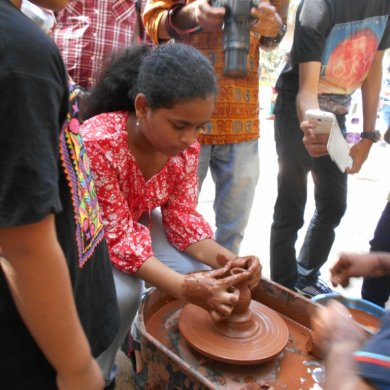 Creating a piece 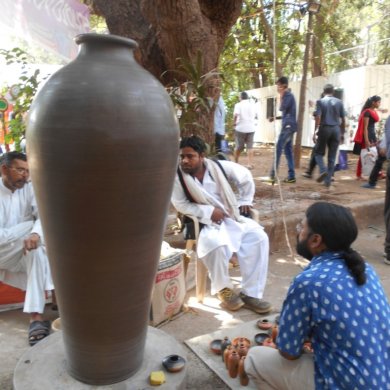 The iconic jar 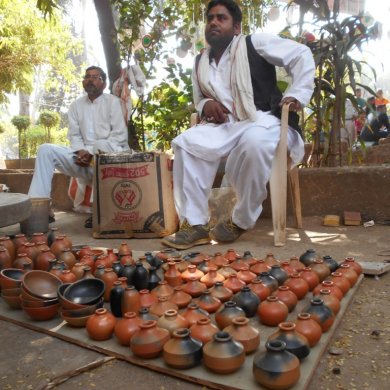 Miniature pieces Beyond the usual sights in exhibition stalls, I stumbled upon a unique setting for STUDIO POTTERY. The site showcased artifacts born of clay: from the most ancient craft to sophisticated ceramic objects and the magic of converting waste to objet d'art. The organizers give the artists a table and a small space to display their items for three days. And a number of artists, some trained, others self-taught put up their shops creating the ambience of an artists’ village. Some of the artists gave a sampling of creating an object. The thrill of creativity marked its exuberance on the faces of those who tried. FINE TERRACOTTA POTTERY displayed earthen pottery by a group hailing from the district of Bharatpur, Rajasthan. The iconic jar sat on the floor lording the miniature ones in front: an emperor of a lost world overseeing his people! It is the tallest jar that I have ever seen. It reminded me of the relics unearthed from ancient archeological sites of human settlements. A symbol of earthen pottery, it is a unique museum piece. The small assortment of earthen ware, miniature art forms meant for showcases, are beauties from the ethnic art of humanity. The group, Motilal Prajapati, Devendra Prajapatu, Tej Singh and Bhan Singh belong to the traditional artisans who are artists of the first order in tune with the ancient tradition of Indian arts. Shayonti Salvi, an artist, the product of Fine Art school, is based in Mumbai. Her pieces are ceramic ware. She has a studio where she imparts training in the art of fine pottery for students who are lovers of art and who want to pursue it seriously. Her items showcase things that people choose as home decor. 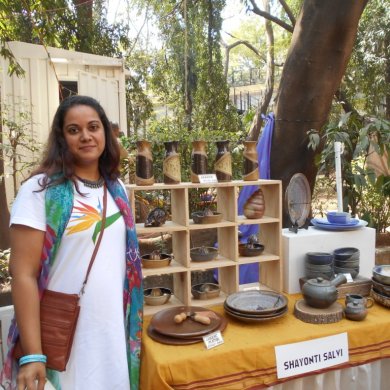 Shayonti Salvi 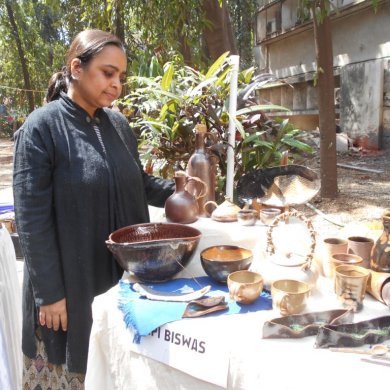 Lipi Biswas Lipi Biswas belongs to a special category of artists for whom art is their religion. Born in Thailand, she met her guru in India in 2000. She prefers to be part of a village. And she lives and works with people for whom crafting clay products is a way of life. The Asian touch in shape and style is the unique stamp of her products. I have come across many artists of many dispositions. Lipi Biswas oozes out simplicity and humility. Married to a painter from Santiniketan she is happy, living close by in a village working with and for rural folk.  The best of waste From the small tables I moved to sites that showed installations. The notable one was a product made of old CDS, the best waste. Children gathered around such mega objects out of fascination for colorful beings of their fantasy world. For environmentalists it is a lesson to make beauties from cast-off useless things we call waste. The success of Kala Ghoda Arts Festival lies in giving inspiration to set up such cultural forums in other parts of Mumbai. Indeed such venues should come up in other parts of our country. Padma Jayaraj is a freelance writer on the arts. She is a regular contributor to www.narthaki.com. |